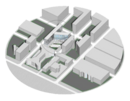
The fourth time we moved office, we took location factors that reduce the burden on the environment into account.
“If you don’t get it right the second time, you’re bound to get it right the third” is a saying that many of you will be familiar with. On moving offices for the third time we should also have managed to take factors that reduce the burden on the environment into account when choosing the location. Following our elation over the economic upturn in information technology until 2001, taking responsibility for a more environmentally-friendly future, beyond a simple cost/utility analysis, won the upper hand when we moved office for the fourth time in 2008.
After 14 years and following three previous moves, we finally took the decision to take ecological determining factors into account for the first time in 2008 (not counting the first few years, when we ran the business from the ground floor of our house in the old town of Bremen).
There’s no question that certain determining factors cannot be resolved generally when selecting the location for a company. For instance, companies with production and warehousing facilities prefer different enterprise zones to those by service companies. For this reason, we have chosen to limit ourselves to those selection criteria that prove interesting from a ecological point of view here. The questions below were of central importance to our choice in particular:
1. How do our employees get to work: car, train/bus or bike?
2. Can we use public transport to get to our customers?
3. How good are the rail and airport links at the location?
4. Can we save energy and water on basic furnishings, kitchen installations
and toilettes?
5. Can we save energy by choosing a more favourable site for the
computer centre?
6. Does the move to the new location allow us to change to an electricity
supplier that provides guaranteed regenerative resources?
7. Are the surroundings designed so that shopping, leisure facilities (pubs,
restaurants, cinemas, theatre…), sport studios and, above all food
and drink establishments can be reached easily on foot, by bicycle or,
at least, public transport.
The following general locations were available in Bremen: a) the business park at Bremen Airport where we were already located – 2 minutes walk to the departure terminal, b) a trendy loft at the former international port – very attractive site owing to it being right next to the dock, c) the city centre – highly favoured in Bremen owing to the historical market square (world cultural heritage) or d) close to the university.

Table: Location analysis (only a few selection criteria) performed in June 2008
What did we achieve by moving into the office block in the city centre?
Share of employees who come to work by bike or bus/train:
Old office at the airport until December 2008: 19%
New office in the city centre following the transition phase: 81%
The ratio of cars to bicycles and public transport when travelling to work is now the direct inverse to what it was before. This is due to three factors:
a) The main station is located right in the middle of the city of Bremen,
b) In agreement with our employees prior to the move, we no longer provide
free parking following the nine-month transition phase, and
c) the shower allows employees who have to travel long distances to work
(between 5 and 28 km) to swap to bikes.
Since nearly 70% of our employees live in the surrounding countryside, with some having distances of over 50 km to travel, this change reduces the burden on the environment considerably (several tonnes of CO2 saved) (cf. CO2 guide to motor vehicles).
One thing that a company cannot influence altogether when renting office space is its development in terms of saving energy. Since in our case, the rented space was in a newly gutted building that was going to be completely refurbished anyway, we were able to influence the choice of the following facilities and installations:
• Energy-efficient lighting
• Well-insulated windows
• Low consumption flush control
• Shower for employees who come by bike
• Energy-efficient electronic appliances such as a fridge based on the newest standards
• Computer centre on the north-facing side so that as much outside air as
possible can be used for cooling
• Electricity for the whole company from guaranteed regenerative sources
Converting to electricity from guaranteed regenerative energy sources proved to be a considerable relief to the environment in particular. Our computer centre alone consumes more than 30,000 kWh of electricity a year, which, in the normal electricity mix in Germany in 2008, meant CO2 emissions of some 18 tonnes (cf. survey by the German Federal Environment Agency).
And last but not least
The board and the employees are in much better spirits now that we are right at the centre of things in the city centre. With the windows open we can sometimes hear buskers playing their accordions, or follow the carnival procession, student demos and firework display at the Christmas market from the balcony.
The already excellent quality of our work has improved again and mixes well with an altogether better atmosphere and feeling of job satisfaction.
